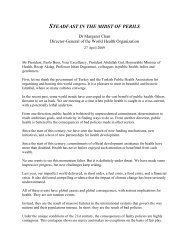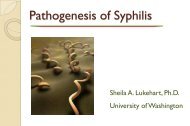The Evolution of HTA in Emerging Markets Health-Care ... - TREE
The Evolution of HTA in Emerging Markets Health-Care ... - TREE
The Evolution of HTA in Emerging Markets Health-Care ... - TREE
Create successful ePaper yourself
Turn your PDF publications into a flip-book with our unique Google optimized e-Paper software.
OHE Consult<strong>in</strong>g Report for PhRMA<br />
5 January 2011<br />
<strong>of</strong> the schemes. Some Prov<strong>in</strong>ces are seek<strong>in</strong>g to <strong>in</strong>tegrate the management <strong>of</strong> the different schemes,<br />
particularly the URBMI and the NRCMS, although they are still adm<strong>in</strong>ister<strong>in</strong>g different benefit<br />
packages. Nationally, there is a debate as to whether the MoHRSS should take over the MoH role,<br />
becom<strong>in</strong>g the purchaser for the NRCMS. <strong>The</strong> MoH would still own the hospitals and employ the<br />
doctors. But the MoH has resisted.<br />
As a consequence <strong>of</strong> the different schemes, the <strong>in</strong>surance benefit is not standardized, and the<br />
benefits are not transferrable from one city to another. <strong>The</strong>re are a large number <strong>of</strong> migrant workers<br />
whose permanent residence is <strong>in</strong> a rural area but whose workplace is <strong>in</strong> one <strong>of</strong> the cities are still<br />
unable to enjoy health benefits because <strong>of</strong> adm<strong>in</strong>istrative rigidity. Research shows that the NRCMS<br />
scheme has reduced migration to the cities as people do not want to lose health <strong>in</strong>surance.<br />
However, this needs to be put <strong>in</strong> context. Many migrant workers are young with limited health care<br />
<strong>in</strong>terests unless they are already sick. When the URBMI has been rolled out it will be possible to<br />
explore whether this has encouraged migration to the cities.<br />
<strong>The</strong>re are differences <strong>in</strong> philosophy between the MoHRSS and the MoH. <strong>The</strong> former is <strong>in</strong>terested <strong>in</strong><br />
security, i.e. <strong>in</strong> treatment once the patient is ill, whereas the MoH has more focus on health<br />
<strong>in</strong>clud<strong>in</strong>g prevention. <strong>The</strong>re is also important heterogeneity <strong>of</strong> services reimbursed (for example,<br />
<strong>in</strong>patient and outpatient, and the type <strong>of</strong> hospital covered) not only across the schemes but with<strong>in</strong><br />
them, depend<strong>in</strong>g on local resources. For example <strong>in</strong> the richer coastal areas the benefit package <strong>in</strong><br />
the UEBMI is better because the enterprises can afford to pay higher wages and also to contribute<br />
more than the m<strong>in</strong>imum percentage <strong>of</strong> salary.<br />
<strong>The</strong> lack <strong>of</strong> autonomy for public hospitals<br />
<strong>The</strong> second challenge to greater <strong>in</strong>tegration <strong>of</strong> health <strong>in</strong>surance schemes relates to the issue <strong>of</strong><br />
public hospitals. Currently, the public hospitals are under the control <strong>of</strong> MoH, and the operation and<br />
management suffers from low efficiency. <strong>The</strong>re are more than 70 million medical staff, but they do<br />
not have the right <strong>in</strong>centives to perform well <strong>in</strong> this system, with service fees strictly under price<br />
control and heavily distorted. Hospital managers are adm<strong>in</strong>istrators – they do not have the power to<br />
hire and fire. Doctors’ wages are too low, creat<strong>in</strong>g dis<strong>in</strong>centives to becom<strong>in</strong>g a doctor at a time<br />
when more and better tra<strong>in</strong>ed doctors are needed. Many older doctors <strong>in</strong> the rural areas are not<br />
well tra<strong>in</strong>ed <strong>in</strong> modern medic<strong>in</strong>e. <strong>The</strong> MoH appears to be reluctant to <strong>in</strong>troduce reform, <strong>in</strong> part<br />
because it uses low wages to keep down health care costs. One solution to this problem could be to<br />
ease the controls on hospitals, give the hospitals their autonomous adm<strong>in</strong>istrative rights, and let<br />
them decide how to <strong>in</strong>vest and allocate the resources with<strong>in</strong> the hospitals. However, this assumes<br />
that payment mechanisms provide appropriate <strong>in</strong>centives.<br />
<strong>The</strong> lack <strong>of</strong> an efficient fee schedule<br />
Evidence from around the world <strong>in</strong>dicates that fee-‐for-‐service is usually not an optimal<br />
reimbursement system. Where it is used it is important that relative fees reflect relative costs and<br />
that, overall, fee levels enable an efficient hospital to cover its costs. <strong>The</strong> exist<strong>in</strong>g pric<strong>in</strong>g mechanism<br />
for medical services <strong>in</strong> Ch<strong>in</strong>a is perverse. Price control by National Development and Reform<br />
Committee (NDRC) prevails <strong>in</strong> this field. Many fee-‐for-‐service charges are now far below the market<br />
price level. Hospitals are unable to cover costs without other revenue sources <strong>in</strong>clud<strong>in</strong>g provid<strong>in</strong>g<br />
services that are not <strong>in</strong>cluded <strong>in</strong> the <strong>in</strong>surance package, so they do not have the right <strong>in</strong>centives to<br />
provide quality care. Doctors salaries are supplemented by bonuses <strong>of</strong> up to 50% <strong>of</strong> salary, l<strong>in</strong>ked to<br />
87








